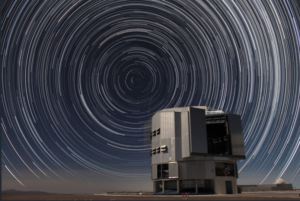When is it important to know how to apply the notions of celestial orientation? Relevant cases are described below, although in essence, you interact with your concepts all the time every time you observe the sky, being of great help to optimize time.
 1st Case: Locate the South Celestial Pole through the Southern Cross constellation. In the Southern Hemisphere, one of the best-known constellations is the Southern Cross, not only because it is the smallest of the 88 official ones or because of the characteristic arrangement of its main stars (in the shape of a cross), but because, in the absence of a bright star located just in the direction of the south celestial pole (unlike what happens in the northern hemisphere, with the star Polaris), amateurs must come up with some techniques to be able to find this imaginary point in the sky. One of them requires using the Southern Cross, as follows:
1st Case: Locate the South Celestial Pole through the Southern Cross constellation. In the Southern Hemisphere, one of the best-known constellations is the Southern Cross, not only because it is the smallest of the 88 official ones or because of the characteristic arrangement of its main stars (in the shape of a cross), but because, in the absence of a bright star located just in the direction of the south celestial pole (unlike what happens in the northern hemisphere, with the star Polaris), amateurs must come up with some techniques to be able to find this imaginary point in the sky. One of them requires using the Southern Cross, as follows:
Project the "main mast" of the Southern Cross, 4 and a half times.
 As seen in the attached image, by making this projection (either with the help of a "green laser pointer" or with the help of the fingers of one hand), it will be possible to reach this location in the sky and use it to your own advantage, for example, when trying to capture an astrophotograph with the South Celestial Pole at the center (like the one in the example).
As seen in the attached image, by making this projection (either with the help of a "green laser pointer" or with the help of the fingers of one hand), it will be possible to reach this location in the sky and use it to your own advantage, for example, when trying to capture an astrophotograph with the South Celestial Pole at the center (like the one in the example).


